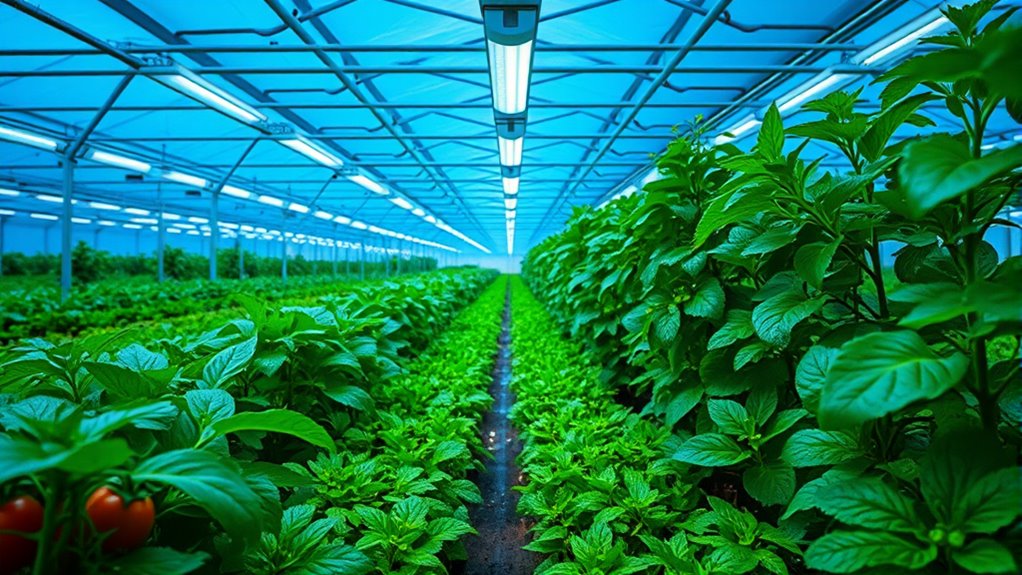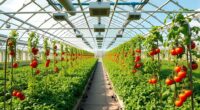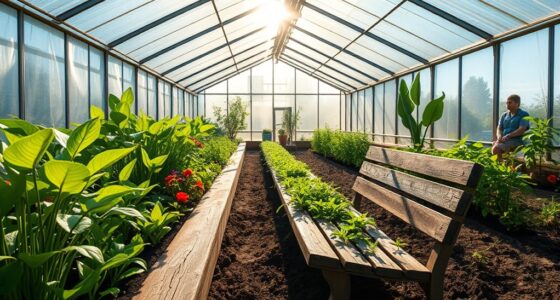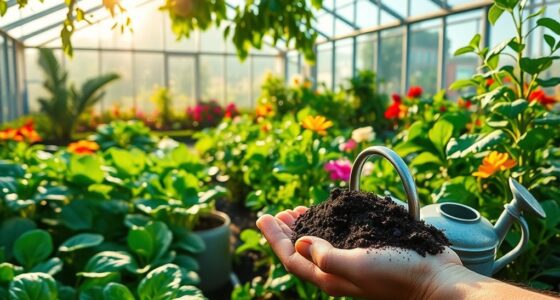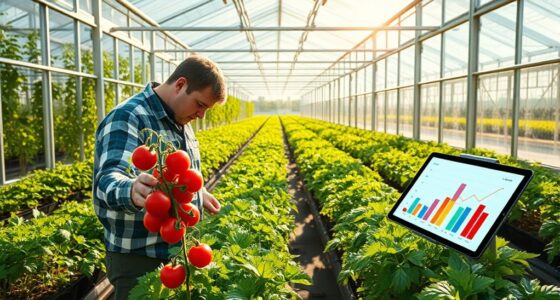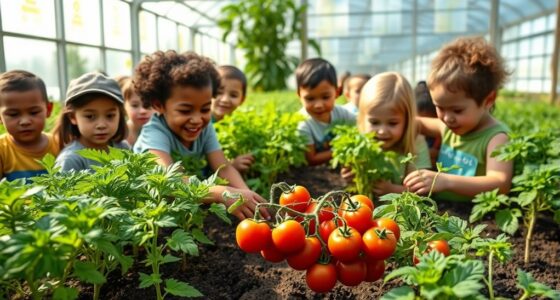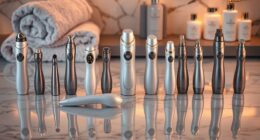Using LEDs in your greenhouse allows you to customize light spectra and intensities to match your plants’ growth stages, making your setup energy-efficient and effective. Blue light promotes healthy vegetative growth, while red helps with flowering and fruiting. Adjusting LED brightness and spectrum guarantees ideal conditions without wasting resources. Proper maintenance and tailored lighting strategies boost plant health and yield. Keep exploring how finely tuning your LED setup can open even better results for your greenhouse.
Key Takeaways
- Select LEDs with a balanced spectrum, including blue (~450 nm) and red (~660 nm), to support all plant growth stages.
- Adjust LED intensity and distance to optimize light levels, preventing stress or stretch in plants.
- Use dimmable LEDs and spectrum controls for precise customization tailored to specific plant needs.
- Regularly clean fixtures and monitor light output to maintain efficiency and extend equipment lifespan.
- Incorporate PAR measurements and responsive management to maximize photosynthesis and resource efficiency.

Have you ever wondered how to keep your greenhouse plants healthy and productive year-round? The key lies in understanding how LED lighting can enhance plant growth through careful management of LED spectrum and light intensity. LEDs offer a versatile and energy-efficient way to provide the precise light conditions your plants need, regardless of the season or outdoor weather. By selecting the right LED spectrum, you can tailor the light to match the specific requirements of different plant species, promoting faster growth, better flowering, and stronger yields.
The LED spectrum refers to the range of wavelengths emitted by the light source. Different wavelengths influence various plant processes, such as photosynthesis, flowering, and root development. For example, blue light (around 450 nm) encourages vegetative growth and compactness, while red light (around 660 nm) promotes flowering and fruit production. Combining these wavelengths allows you to create a balanced light environment that supports your plants’ entire life cycle. You can also incorporate additional spectrum ranges, like far-red or ultraviolet, to fine-tune the lighting for specialized growth stages or aesthetic purposes. Understanding the spectral composition of your LED lights ensures optimal plant responses.
Adjust LED spectrum to optimize photosynthesis, flowering, and root growth for healthier, more productive plants.
Light intensity plays a critical role in how plants respond to LED lighting. If the light is too weak, your plants may stretch and grow slowly, leading to weak stems and poor yields. On the other hand, excessive light intensity can cause stress, leaf burn, or increased energy consumption without delivering proportional benefits. Striking the right balance involves adjusting the LED brightness or distance from the plants to achieve ideal light levels. A good rule of thumb is to measure the photosynthetically active radiation (PAR) and ensure it aligns with the needs of your specific plants. For leafy greens, moderate intensity suffices, while flowering plants may require higher levels of light.
Managing both LED spectrum and light intensity effectively allows you to maximize your greenhouse’s productivity while saving energy costs. LEDs can be dimmed or adjusted easily, giving you precise control without the need for complex or expensive setups. By monitoring your plants’ responses and tweaking the spectrum and intensity as needed, you create an environment that promotes healthy growth all year long. Additionally, understanding the importance of regular maintenance and proper cleaning of your LED fixtures can ensure consistent light output and prolong the lifespan of your equipment. This targeted approach not only boosts plant health but also enhances resource efficiency, making your greenhouse operation more sustainable and profitable. Ultimately, understanding and manipulating these factors empower you to cultivate thriving plants regardless of external conditions, ensuring your greenhouse remains productive, vibrant, and resilient throughout every season.
Frequently Asked Questions
How Do LED Grow Lights Compare to Traditional Incandescent Bulbs?
LED grow lights outperform traditional incandescent bulbs in many ways. You’ll notice they use less energy, making them more energy-efficient. Plus, they produce minimal heat output, so you don’t need to worry about overheating your plants or increasing cooling costs. LEDs also last longer and provide targeted light spectrums ideal for plant growth, making them a smarter, more efficient choice for your gardening needs.
What Is the Ideal LED Wavelength for Different Plant Types?
You want to know the ideal LED wavelength for different plant types. Spectral optimization plays a key role here, as you need plant-specific wavelengths to maximize growth. For example, blue light (around 450 nm) supports foliage, while red light (around 660 nm) encourages flowering. Adjusting the spectral output ensures your plants receive targeted light, boosting efficiency and health. Tailoring LED spectra to plant needs creates perfect growth conditions.
How Does Light Intensity Affect Plant Growth Rates?
Oh, the glorious quest for perfect plant growth—who knew light could be so dramatic? When you increase light intensity, you boost photosynthesis efficiency up to the light saturation point. Beyond that, plants don’t grow faster; they just waste energy. So, you need just enough light to reach that sweet spot without overdoing it. That’s how you maximize growth without turning your plants into energy-hungry divas.
Can LEDS Be Used for Outdoor Greenhouse Lighting Year-Round?
Yes, you can use LEDs for outdoor greenhouse lighting year-round. LEDs are designed for outdoor durability, so they withstand weather conditions like rain and wind. Plus, they allow for seasonal adjustments, giving you control over light intensity and spectrum to match plant needs throughout the year. This flexibility helps guarantee ideal growth regardless of the season, making LEDs a reliable, energy-efficient choice for continuous outdoor greenhouse lighting.
What Are the Long-Term Cost Savings of LED Lighting Systems?
While initial investment is higher, you’ll notice long-term cost savings with LED lighting. Their energy efficiency reduces your electricity bills, and lower maintenance costs mean fewer replacements and less labor. Over time, this combination markedly outweighs upfront expenses, making LEDs a smart choice. You’ll enjoy consistent performance, lower operating costs, and a more sustainable setup—saving you money and effort in the long run.
Conclusion
By choosing LED lighting for your greenhouse, you can boost plant growth efficiently and sustainably. Imagine a small-scale tomato farmer who switched to LEDs, resulting in faster growth and higher yields within a season. With your own setup, you’ll enjoy healthier plants, lower energy costs, and a more eco-friendly operation. Embrace LED technology today, and watch your green space thrive like never before. Your plants—and your wallet—will thank you!
